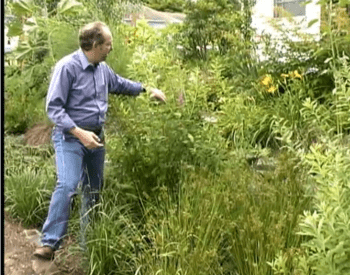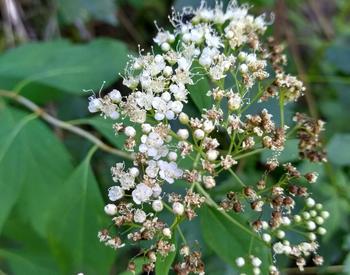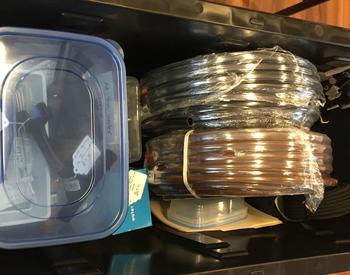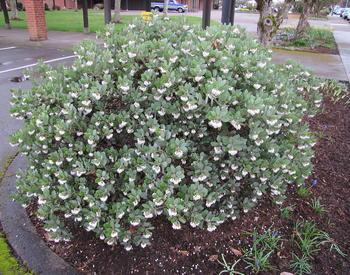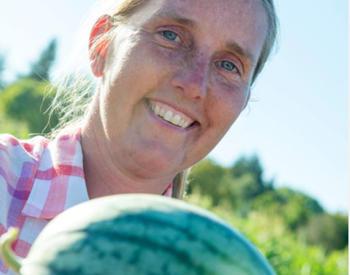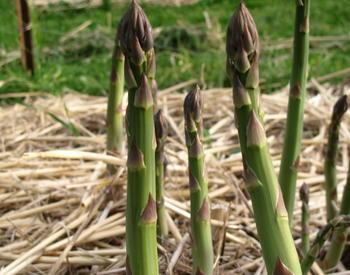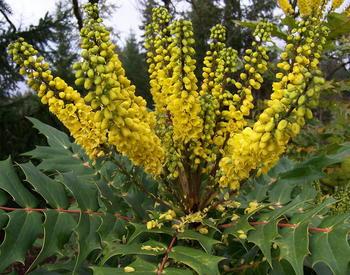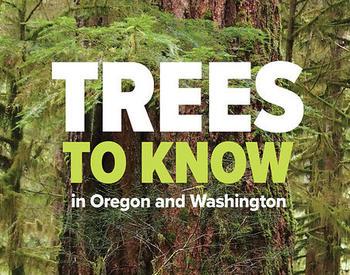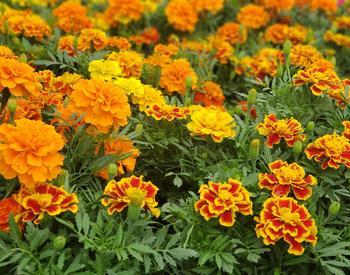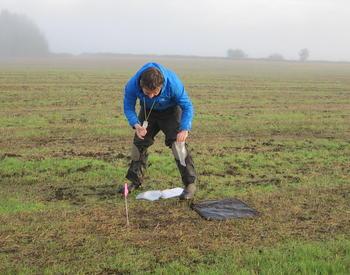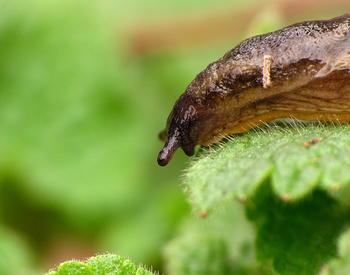Western Hemlock-Douglas Fir Forest
The most common plant community in the Pacific Northwest is dominated by large conifers, with a wide range of trees, shrubs, and groundcovers as understory plants. Groundcovers will vary depending on amount of sunlight and moisture. A number of species are common throughout the moist to dry range with a few species found at one end of the gradient or the other. For instance, in places where the soil is well drained and the slope is south-facing, or in open canopy sunny conditions, you will find plants more tolerant of dry conditions. Many of these plants will grow in mixed deciduous forest conditions as well.
Vine Maple, Acer circinatum
Large shrub or small tree. Ht. 20’. Part sun/shade. Tolerates seasonal wet. Birds eat seeds; branches are good for nesting sites. Butterfly larvae host plant.
Notes: Understory tree. Only plants nursery grown in the sun should be planted in sun conditions. Shade-grown plants do not transplant well to sun conditions. Flowers in April before leaves. Lovely fall color.
Indian Plum/Oso Berry, Oemleria cerasiformis
Large shrub or small tree. Ht. 8-15’. Full sun/full shade. Tolerates seasonal dry. Birds eat berries.
Notes: More open form in shade. Generally grows less wide than tall. Often suckers at base. High transplant success. Need male and female plants for the fruit to develop (female fruits). First to flower (February) and leaf out in spring, flower scent described as Hawthorne-like, almond-scented or a cross between melon rinds and cat urine. Pollinated by bees and flies. First to fruit (June), eaten quickly by birds, quite palatable fruit. Often seed planted by birds. Fast grower. Leaves have strong cucumber smell when crushed.
Red Flowering Currant, Ribes sanquineum
Large shrub. Ht. 6-8’. Part shade/full sun. Tolerates seasonal dry. Birds eat berries, hummingbirds, butterfly adult, butterfly larvae.
Notes: Alternate host for White Pine Blister Rust. Many named forms available, some garden origin, some naturally found varieties. Generally upright but can develop interesting form, especially in shade—becomes leggier. Powdery blue, black berries ripen from June to August, are edible. Almost always eaten by summer’s end by birds. Fruit is eaten by mammals (deer, foxes, beavers, raccoons, and squirrels), twig/foliage browsed by deer. David Douglas brought this plant to European horticulturists.
Red Huckleberry, Vaccinium parvifolium
Shrub. Ht. 4-6’ usually, up to 10’. Part sun/full shade. Tolerates seasonal wet. Birds eat fruit, hummingbirds.
Notes: Plant with rotting wood, decaying organic matter increases transplant success according to some growers. Can look dead for up to two years so don’t give up hope and pull it. Alternate leaves, square stems.
Evergreen Huckleberry, Vaccinium ovatum
Evergreen shrub. Ht. 3-8’ usually, up to 15’. Part sun/full shade. Birds eat fruit, hummingbirds, butterfly adult, butterfly larvae, bees.
Notes: Will take formal pruning—good substitute for boxwood (which is toxic to dogs, cats, and horses). New spring growth is lovely burgundy/bronzy color. Slow grower. Fairly compact in sunny areas, more upright, taller with more shade. Berries better with more sun, which get supposedly sweeter after frost. Important food source in late summer and early fall for wildlife. Foliage used in florist trade.
Thimbleberry, Rubus parvifolius
Shrub. Ht. 5’-9’. Full sun/full shade. Tolerates seasonal wet. Birds eat raspberry-like fruits.
Notes: Large, felty leaves. No thorns. Thicket-forming bramble—good to compete (with help) against Himalayan blackberry. Vigorous, not for the small garden. White flowers appear after many other natives are done flowering. Good soil-binding characteristics, good for erosion control. Transplant success high.
Salmonberry, Rubus spectabilis
Shrub. Ht. 2-6’. Full sun/full shade, Tolerates seasonal wet. Birds (25) eat raspberry-like fruits.
Notes: Sparsely thorned, thicket-forming bramble – good to compete (with help) against Himalayan blackberry. Vigorous, not for the small garden. Hot pink flowers before the foliage. The fruit is quite mushy but some clones are tastier than others. Good soil-binding characteristics, good for erosion control. Transplant success high.
Salal, Gaultheria shallon
Evergreen shrub. Ht. 2-6’. Part sun/full shade. Tolerates seasonal wet. Birds eat berries, hummingbirds, butterfly adult, butterfly larvae.
Notes: Slow to establish. Can take 2–3 years before spreads. Most prevalent understory shrub in the region. Can form dense thickets; can be difficult to remove. Generally stays at 3’ or under in the valley, taller on the coast. Tasty jam. Another whose foliage is used in the florist trade.
Fringe cup, Tellima grandiflora
Herbaceous perennial. Ht. 1’-2’. Part shade/full sun. Tolerates seasonal wet.
Notes: Name “fringe cup” describes the flower in which the petals, highly divided, create a fringe around the floral cup. Can seed around, offsets easy to transplant, easy to naturalize.
Western trillium, Trillium ovatum
Herbaceous perennial. Ht. 1.5’. Part shade/full sun. Tolerates seasonal wet. Ants.
Notes: Most widespread of our four native species. Easy to grow but slow from seed (can take two years to germinate), seven years to flower. Goes dormant after flowers. Flowers are white, fade to pink, darkening as they fade. Squirrels and chipmunks eat the seeds. Do not cut. Three leaves, three petals. Difficult to salvage; take only when colony is doomed and with permission.
Inside Out Flower or Duckfoot, Vancouver hexandra
Herbaceous perennial. Ht. 12”-18”. Part sun/full shade.
Notes: Spreads by rhizomes, nice habit, not pushy. Kruckeberg recommends mixing with Salal, rhodies, pachystima. Closest relative is epimedium. Seeds dispersed by wasps and ants. Named after explorer Capt. George Vancouver.
Western Bleeding Heart, Dicentra formosa
Herbaceous perennial. Ht. 1’-1.5’. Part shade/full sun. Moist but not standing water. Hummingbirds, butterfly adult, butterfly larvae, ants.
Notes: Foliage is toxic if ingested. White flowered form available. NWF lists this as one of the top 10 plants for habitat gardening. Transplants and spreads easily but is not aggressive (YMMV). Greenlace wings.
Bunchberry, Cornus canadensis
Herbaceous perennial. Ht. 4”-6”. Full shade. Moist soil all year long. Birds, Butterfly adult.
Notes: Plant with rotting wood, decaying organic matter. Rich, moist, acidic soils. Difficult to establish, more luck with well-grown seedlings than transplanted clumps. In mild winters, leaves are semi-evergreen and burgundy colored. Partners well with twinflower, vanilla leaf. Flowers May to June.
Stream Violet, Viola glabella
Herbaceous perennial. Ht. 4”-5”. Part sun/full shade. Moist soils. Butterfly Adult, butterfly larvae, Ants.
Notes: Largest native violet with yellow flowers. Explosive seed capsules will carpet the ground (take care when harvesting seed). Mix with woody plants, great for wetter woodland garden. Spring bloomer.
Mixed Deciduous Forest/Steep Dry Slope
Extremely well-drained, exposed south slopes, this community is predominately a mixture of deciduous trees with scattered conifers. Garry oak and bigleaf maple are the dominant trees. Conifers do not favor the dry conditions and thin, rocky and well-drained soils. Where the tree canopy is more open, a wider variety of herbaceous plants and grasses can be found.
Saskatoon or Serviceberry, Amelanchier alnifolia
Large shrub/small tree. Ht. 8’-15’, can reach 30’. Full Sun/part shade. Birds eat fruit, Hummingbirds, Butterfly adult, Butterfly larvae.
Notes: Avoid planting less than 30 feet from Incense Cedar—alternate host for rust. Roots sensitive to competition, slow to establish. Lovely flowers on par with mock orange and pearl bush. Great fall color. Common name of Serviceberry is for other regions more than ours but they have been interchangeable. Serviceberry got its name because bloom would signal that the ground was soft enough to dig graves and hold services. Susceptible to rust though usually not disfiguring. Take care not to plant with other plants affected by same rust (crabapples, pears, junipers).
Ocean Spray, Holodiscus discolor
Large shrub/small tree. Ht. 8’-12’. Full Sun/part shade. Songbird shelter, Butterfly adult, Butterfly larvae.
Notes: June to August bloom with the fruit, a tiny, persistent capsule, drying very nicely to buff color, adding year-long interest. Transplantation success is high. Growth rate is fast. Good soil-binding qualities, tolerates salt air, extremely drought tolerant and good for disturbed sites. Provides winter forage for insectivorous birds such as chickadees and bushtits. Birds eat the seeds. Incredibly hard wood made stronger by heat, pegs can be used in construction.
Mock Orange, Philadelphus lewisii
Large shrub/small tree. Ht. 6’-10’. Full sun/part shade. Birds, Butterfly adult, Butterfly larvae.
Notes: Poisonous seeds. Fragrant bloom in early-mid summer. Fast grower, easy to grow, high transplant success, good erosion control. Great for the back of borders, informal hedges or specimen plant when lightly shaped.
Dull Oregon Grape, Mahonia nervosa
Evergreen shrub. Ht. 2’-3’. Part sun/full shade. Tolerates seasonal wet. Birds (6) eat fruit, Butterfly adult, Butterfly larvae, Mason bees.
Notes: Slow spreading, makes an attractive ground cover, suffocating weeds and requires no pruning or special care. Can tolerate deep shade. Reputed deer resistant foliage but other sources don’t confirm. Blue fruits are edible (jam, jellies with lots of sugar, can also make wine) but the flesh is minimal and the seed big. Lot of work.
Sword Fern, Polystichum munitum
Evergreen fern. Ht. 2’-3’. Part sun/full shade. Provides winter protection for birds.
Notes: Transplants well, easy to establish. Looks best planted in groups or drifts in the woodland or rhodie garden. Spores spread around the garden for new plants. Our only fern, which can handle more sun/more dryness than all others. With age, can reach heights of 5’. Leaf looks like a sword, hence the name.
Prairie
This community is most common in the middle and southern Willamette Valley, although some prairies did exist within the Columbia Corridor, on Sauvie Island, and in the Tualatin Valley.
Historically these areas were burned by Native Americans, which helped maintain their open grassy character. Today the extent of this type of plant community is gone due to development, elimination of burn practices and the subsequent natural process of forest succession.
Prairies are comprised primarily of grasses on well-drained dry upland sites. If trees and shrubs are present, they are typically found alone or in small groups. The number of trees and shrubs present will depend on the depth of the soil and available moisture and they are tolerant of shallow dry soils and sunny exposed conditions.
California Wax Myrtle, Myrica californica
Evergreen shrub. Ht. 6’-15’. Fun sun/part shade. Birds.
Notes: Foliage fragrant when brushed/crushed. Very drought tolerant. Great hedge plant. Will take shearing. Flower is insignificant. Small nutlet is eaten by birds. Coastal plant.
Fireweed, Epilobium angustifolium
Herbaceous perennial. Ht. 3’-4’. Full sun. Hummingbirds, Butterfly adults, bees.
Notes: Pioneer plant for disturbed sites. About 2 weeks of bloom in late summer. Source of excellent honey. Fruits are pod-like capsules. Seeds prolifically – do not expect it to remain in a restricted area. Cut it to the ground before it seeds to contain its habit. Kruckeberg recommends “lovely, non-invasive white form” which is in limited cultivation. Leaves are rich in Vitamin C, can be used to make tea. Prevalent on the outer coast.
Aster, Aster spp.
Herbaceous perennial. Ht. 3’. Full sun. Butterfly Adult, bees.
Notes: Great late season bloomer. Varieties can range from alpine types forming compact mounds of 6” to open branched forms 6’ tall. Flowers white, shades of blue, pink, red, lavender, or purple, mostly with yellow centers. Compact or cushion forms make tidy edges, mounds of color in rock gardens and good container plants. Open meadow species are better for perennial border use. Member of the sunflower family, the flower is a compound flower, which attracts many different pollinators. Easy to grow from seed or division.
Red Columbine, Aquilegia formosa
Herbaceous perennial. Ht. 2’-3’. Full sun/part shade. Birds eat seed, Hummingbirds, Butterfly adult.
Notes: Spring/early summer bloom. Easily grown from seed. Cross breeds with other species with seedlings differing from parents. Older, less hybridized varieties better for pollinators. Cut back old stems for the second crop of flowers; leave some to self-sow and for seed-eating birds. Reputably less prone to powdery mildew than hybrids. Leaf minors a problem, just cut foliage back for a new flush of undamaged growth.
Yarrow, Achillea millefolium
Herbaceous perennial. Ht. 1’-2’. Full sun. Butterfly adult, Beneficial insects.
Notes: Relative of asters, compound flower heads. Easy perennial, long bloom (summer/early fall). Leaves are aromatic. Pure species is white-flowered but varieties can be red, pink, yellow or white. Tall species can spread quickly and are easily divided when clumps get crowded.
Pearly Everlasting, Anaphalis margaritacea
Herbaceous perennial. Ht. 18”-2’. Full sun. Butterfly adult, Butterfly larvae, beneficial insects (syrphid fly, small wasps)
Notes: Dried flower even in bloom (papery bracts). Easy to grow, late summer bloomer. Spread by rhizomes and seeds (easy to grow from seed).
Penstemon, Penstemon cardwellii
Evergreen perennial/subshrub. Ht. 4”-12”. Full sun. Tolerates seasonal dry. Hummingbirds, Butterfly adult, bees, night-flying moths.
Notes: Needs good drainage, plant in gravel or pumice (pumice best – more air pockets). Plant in weed barrier tube. Most common form around here – OR has about 30 species of penstemons. All forms cross breed easily so seed may not be true to the parent. Can be short-lived, will root along where branches touch the ground. Root run is 8”-10” deep usually. Prefers acidic soils. Partners – Oregon sunshine, California fuchsia, Scarlet gilia, Lewisia.
Penstemon, Penstemon rupicola
Evergreen perennial/sub shrub. Ht. 2”-4”. Full sun. Tolerates seasonal dry. Hummingbirds, Butterfly adult, bees, night-flying moths.
Notes: Needs good drainage, plant in gravel or pumice. Same as above. Rupicola means “growing on rocks”. Usually grows on vertical rock. Doesn’t need full sun, can take north side.
Kinnikinnick, Arctostaphylos uva-ursi
Evergreen shrub. Ht. 6”. Full sun/part shade. Tolerates seasonal dry. Birds, Butterfly larvae, bees.
Notes: Slow to establish but once established very drought tolerant, takes foot traffic. Great replacement for lawn in parking strip, for hard-to-mow slopes. Lovely peeling bark on older plants. Planted on top of a rock wall for drapery of greenery. Roots along branches as it grows. Longest palindromic word in the English language. Fruits are edible but mealy, tasteless and have hard seeds. Birds like them though. Leaf tips sometimes deformed due to aphid but only cosmetic damage, no worry. Do not leave fall leaves/plant debris on top. It must be raked off.
Broad-leaved Stonecrop, Sedum spathulifolium
Evergreen perennial. Ht. up to 6”. Fun sun/part shade. Well-drained soils. Butterfly adult, Butterfly larvae, Bees.
Notes: Bright yellow flowers in early to mid summer. Easy to propagate by rooting a piece of stem.
Beach Strawberry, Fragaria chiloensis
Evergreen perennial. Ht. 4-6”, indefinite spread. Full sun. Tolerates seasonal dry. Birds, Butterfly larvae.
Notes: One parent of cultivated strawberry, very tasty fruit. Propagates easily from runners. Great, quick-growing groundcover for around woody shrubs, robust perennials. Can overrun daintier perennials. Thrives on sand dunes and beaches.
Scrub-Shrub Wetlands
This plant community occurs on lake shores, gravel bars and in poorly drained areas. Growing conditions range from moist soils, to periodic flooding, to standing water. Plants are adapted to seasonal changes in water levels. Some riparian areas are dense thickets of willows, red osier dogwoods, roses. In other areas, scattered trees such as cottonwoods and ash are present. At the edges, where the ground if higher and less wet, plants that tolerate somewhat drier conditions will be found.
Western Crabapple, Malus fusca
Tree. Ht. 6’-15’. Full sun/part shade. Tolerates seasonal wet/standing water. Birds (20) eat fruit, Butterfly Adult, Butterfly larvae.
Notes: Edible, but tart fruit. Fruit eaten by mammals as well. One source listed as fragrant flowers. Good fall color. Great for wetland restoration. No thorns. Can grow into dense thicket and up to 30’ tall and wide eventually. Very salt-tolerant. Cavity nesting birds and other wildlife may nest or roost in tree cavities of large trees.
Red Osier or Red Twig Dogwood, Cornus sericea (var. stolonifera)
Shrub. Ht. 4-10’ can be up to 18’. Full sun/full shade. Birds (24) eat fruit, Butterfly adult, Butterfly larvae.
Notes: Transplant success is high. Fast growth. Can be thicket forming. Good barrier plant. To control size, root prune; prune to ground every 3rd year; prune back 1/3 yearly; or prune 1/3 out yearly. Pruning improves winter appearance – new growth is bright red. White flat cluster of flowers May to July. White berries are bitter and contain a large seed (berries reportedly can be bluish). Good fall color – deep purplish color. Dwarf forms available – ‘Isanti’, ‘Kelseii’.
Nootka Rose, Rosa nutkana
Shrub. Ht. 5’-10’. Full sun/part shade. Tolerates seasonal dry. Birds, Butterfly adult, Butterfly larvae, leaf-cutter bee.
Notes: Good for all sites listed. One of 4 native roses. Once blooming, large single pink flower. Pear-shaped hips are reddish/purplish – feed many birds and mammals. All varieties will eventually form thickets, providing excellent nesting cover. Require no tending, summer water and fertilizer will produce larger, more robust plants. Suitable for informal gardens, wildlife gardens, hedgerows, and fence lines. Will sucker (own roots, not bud union). Can propagate from suckers. Attracts aphids, which are food source for birds and ladybugs. Gymnocarpa rose (baldhip rose) will also grow in this plant community.
Other plant partners: rushes, sedges, blue camas, Wapato.
Bibliography
- Common Poisonous Plants and Mushrooms of North America. Turner & Szczawinski. Timber Press.
- Gardening With Native Plants of the Pacific Northwest. Arthur R Kruckeberg University of Washington Press, revised 1996
- Grow Your Own Native Landscape. Michael Leigh. Washington State University Extension, Thurston County
- Landscaping for Wildlife in the Pacific Northwest. Russell Link University of Washington Press, 1999
- Naturescaping: A Landscaping Partnership with Nature. Oregon Department of Fish and Wildlife. Revised edition 2001.
- Plants Of the Pacific Northwest Coast. Pojar & MacKinnon Lone Pine, 1994
- Poisonous Plants Encountered in Oregon. Circular #801. Oregon State Extension Service.
- Portland Plant List. City of Portland, Bureau of Planning, amended 1997. Also available through the Naturescaping for Clean Rivers program.

